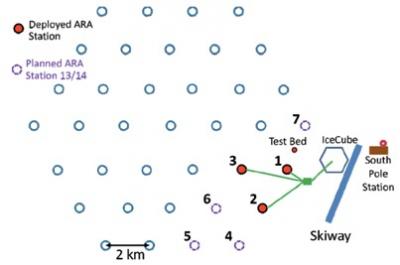Overview
Students will learn about the difference between the methods of neutrino detection – optical versus radio. This will then allow them to understand why the relative size of the detectors is so different. Students will also engage in a hands-on activity to understand scale through creating models of the two detectors.
Objectives
Students can understand the scale size of a neutrino detector and explain why radio detectors can be much larger than an optical detector.
Lesson Preparation
Students should also know how to create conversions for scale calculations.
Procedure
- Students will receive an overview of the difference between optical and radio detectors and learn about the importance of the two types of neutrinos these detectors will capture.
- Students will then create a drawing and a model of the detectors using scale calculations:
- Sketch out a design of the IceCube neutrino detector in relation to the Askaryan Radio Array detector. Be sure the sketch is to scale. Include units and label all components. Get teacher approval.
 Map of IceCube and ARA stations to be used in creating 3D model
Map of IceCube and ARA stations to be used in creating 3D model
- Gather supplies for the model.
- Create a 3-D model of the IceCube and ARA neutrino detectors that is to scale and includes a legend that describes all components of the model.
Extension
Find a way to display these in the classroom. Students can create write-ups that explain the models and be hung in frames on the wall by the models.
Assessment
Formative assessment:
Ask students to write down 3 things that they learned on an exit card to check for understanding.
Author/Credits
Lesley Anderson, PolarTREC Teacher 2017
High Tech High School
Chula Vista, CA
landerson [at] hightechhigh.org
Standards Other
NGSS Standards
HS-PS1-8 Matter and its Interactions
Develop models to illustrate the changes in the composition of the nucleus of the atom and the energy released during the processes of fission, fusion, and radioactive decay.
| Attachment | Size |
|---|---|
| Full Lesson: Creating 3-D Models of Neutrino Detectors (PDF - 176 KB)176.05 KB | 176.05 KB |
| Lesson Materials (PDF - 53 KB)53.37 KB | 53.37 KB |
